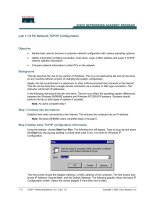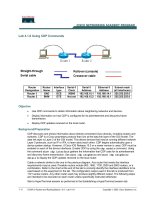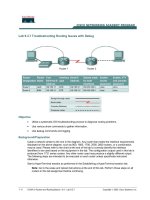Tài liệu Lab 2.3.6 OSI Model and TCP/IP Model doc
Bạn đang xem bản rút gọn của tài liệu. Xem và tải ngay bản đầy đủ của tài liệu tại đây (64.35 KB, 1 trang )
1 - 1 CCNA 1: Networking Basics v 3.0 - Lab 2.3.6 Copyright 2003, Cisco Systems, Inc.
Lab 2.3.6 OSI Model and TCP/IP Model
Objective
• Describe the four layers of the TCP/IP model.
• Relate the seven layers of the OSI model to the four layers of the TCP/IP model.
• Name the primary TCP/IP protocols and utilities that operate at each layer.
Background
This lab will help to develop a better understanding of the seven layers of the OSI model. Specifically
as they relate to the most popular functioning networking model in existence, the TCP/IP model. The
Internet is based on TCP/IP. TCP/IP has become the standard language of networking. However,
the seven layers of the OSI model are the ones most commonly used to describe and compare
networking software and hardware from various vendors. It is very important to know both models
and be able to relate or map the layers of one to the other. An understanding of the TCP/IP model
and the protocols and utilities that operate at each layer is essential when troubleshooting.
Steps
1. Use the table below to compare the OSI layers with the TCP/IP protocol stack. In column two,
indicate the proper name for each of the seven layers of the OSI model corresponding to the
layer number. List the TCP/IP layer number and its correct name in the next two columns. Also
list the term used for the encapsulation units, the related TCP/IP protocols and utilities that
operate at each TCP/IP layer. More than one OSI layer will be related to certain TCP/IP layers.
OSI comparison with TCP/IP Protocol Stack
OSI # OSI Layer
Name
TCP/IP # TCP/IP Layer
name
Encapsul.
Units
TCP/IP
Protocols at
each TCP/IP
layer
TCP
Utilities
7
6
5
4
3
2
1









